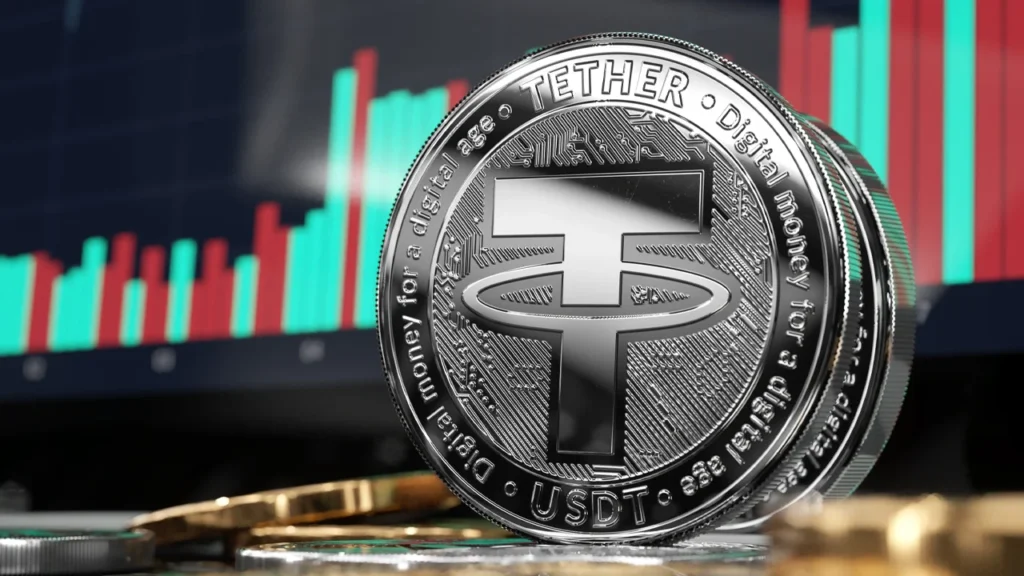
What is Tether (USDT)?
USDT is the symbol for Tether, a cryptocurrency pegged to the US dollar. This means that USDT is a stablecoin whose value fluctuates with the US dollar and is backed by Tether’s dollar reserves. USDT is issued by Tether, a company owned by iFinex, a Hong Kong-registered company that also owns the BitFinex crypto exchange.
As of March 2024, USDT was the third largest cryptocurrency after Bitcoin (BTC) and Ethereum (ETH), and the largest stablecoin with a market capitalization of almost $99 billion. In 2023 and early 2024, Tether USDT accounted for the majority of other cryptocurrency exchanges by volume.
Understanding Tether (USDT)
USDT, or Tether, belongs to a fast-growing type of cryptocurrency called stablecoins, which avoids the extreme volatility of untethered cryptocurrencies by typically pegging its value to the price of a traditional currency such as the US dollar.
Originally based on the Bitcoin blockchain, Tether now supports the Omni and Liquid Bitcoin protocols, as well as Ethereum, Avalanche, Kava, Polka, TRON, EOS. , Algorand and Solana. Their USDT tokens pegged to the US dollar.
How is the currency pegged?
A pegged currency is often backed by reserves consisting entirely or mostly of the pegged currency. Some fiat currencies are pegged to the US dollar, including the currencies of Panama and Saudi Arabia. This protects the currencies from sharp fluctuations in value as their trading value moves with the US dollar.
The same price stability underlies pegged cryptocurrencies.
Tether Transparency
Tether updates its reserve information daily on its website. As of March 3, 2024, its USDT holdings were $99.45 billion. The company reported that 84.58% of its reserves consisted of cash, cash equivalents, short-term deposits and commercial paper; 76.87% of this amount came from US Treasury bills.
It also had 0.05% reserves in corporate bonds, 3.62% in precious metals, 2.91% in Bitcoin, 4.95% in secured loans to third party entities and 3.89% in other investments.

History of Bondage
In November 2017, Tether reported the electronic theft of $31 million worth of USDT tokens. The company implemented a hard fork, a security technique that involves dividing the blockchain into two streams.
2019
In April 2019, New York Attorney General Letitia James obtained a court order prohibiting Tether and iFinex, BitFinex’s parent company, from further violating New York law. BitFinex was found to have borrowed at least $700 million from Tether reserves to offset BitFinex’s corporate and client funds frozen (and ultimately seized) from its Panamanian banking partner Crypto Capital Corp. during a money laundering investigation.
2021
In February 2021, Tether and BitFinex settled the case, agreeing to pay an $18.5 million fine, suspend trading with any New York State resident or entity, and provide information about.
In October 2021, the US Commodity Futures Trading Commission (CFTC) announced that Tether had agreed to pay a $41 million fine “for claims that the Tether stablecoin is fully backed by US dollars.” In fact, “Tether had sufficient fiat money reserves in its accounts to support USDT Tether tokens in circulation on only 27.6% of days during the 26-month sample period from 2016 to 2018,” the CFTC reports. Bitfinex agreed to pay a $1.5 million fine to resolve separate CFTC charges as part of a settlement.
2022
In May 2022, Tether’s price briefly dropped to $0.96 after TerraUSD (UST) was unpegged, even though it was not an affiliated issuer of Tether or BitFinex. The price of Tether tokens quickly recovered to above $0.99, and Tether said it continued to honor redemption requests at a 1-to-1 rate per US dollar.
Tether also launched MXNT, a stablecoin backed by the Mexican peso, following previous expansions in Europe (EURT) and China (CNHT).
2023
In 2023, Tether expanded into the artificial intelligence space by acquiring Northern Data Group. He named a new CEO: Paolo Ardoino, a former CTO and active proponent of financial solutions in the field of cryptocurrencies and blockchains.
That same year, the long-running lawsuit against Tether and Bitfinex finally came to an end after Judge Laura Swain dismissed the lawsuit in November 2023.
The company also continued to take various measures to improve the security of cryptocurrencies, educate users and legislators, and cooperate with law enforcement agencies.
How is USDT different from other cryptocurrencies?
Other examples are USD Coin (USDC), Binance USD (BUSD) and Dai (DAI).
One of the benefits of peg is that it allows investors to easily move money between cryptocurrency markets and the traditional financial system. They won’t have to wait for the business value to plummet.
How can I buy USDT?
Some online brokers also offer cryptocurrencies.
Is Tether the largest stablecoin?
Yes, Tether was the first and most famous stablecoin in the cryptocurrency world. As of March 2024, the company’s market capitalization was nearly $99 billion.
Bottom line
To do this, it maintains enough real currency or its equivalents in reserves so that the cryptocurrency has the same value as fiat currency.
Tether is primarily used to convert cryptocurrencies into fiat currency to prevent slippage or diminution of value between the initiation and completion of a transaction. However, there are times when it is not exactly tied to the fiat currency it is supposed to track. For example, when the FTX exchange crashed in November 2022, the value of Tether fell to almost $0.995, but quickly recovered, at times seeing a peg of more than 1 to 1.
Please read our warranty and disclaimer for more information. At the time of writing, the author does not own any cryptocurrency.